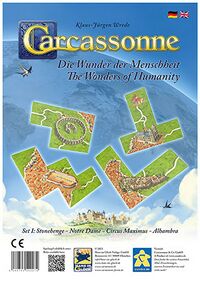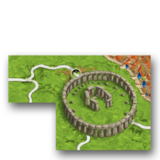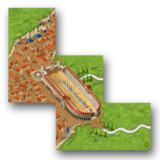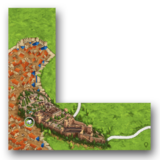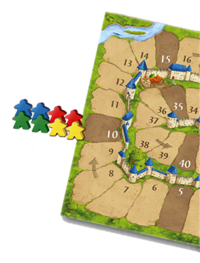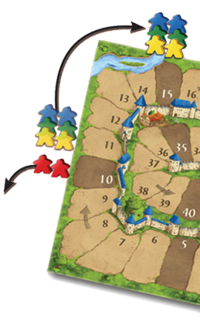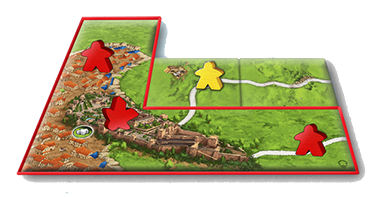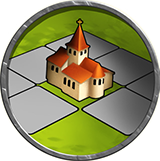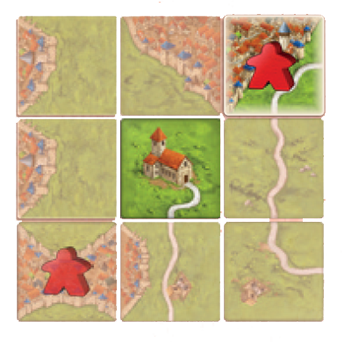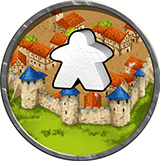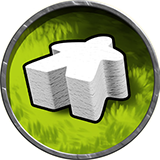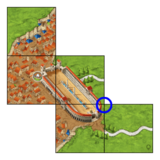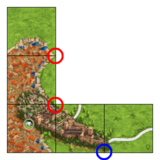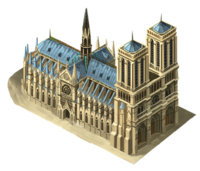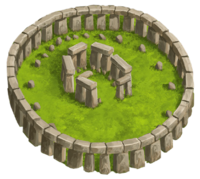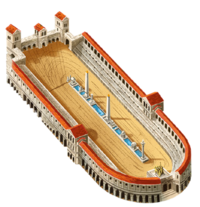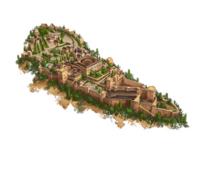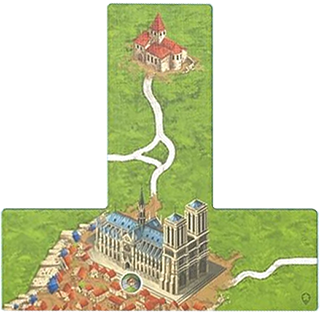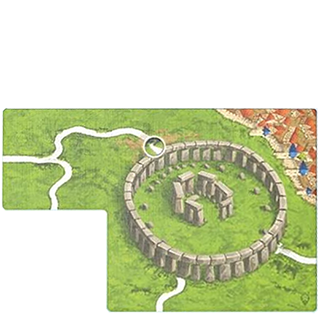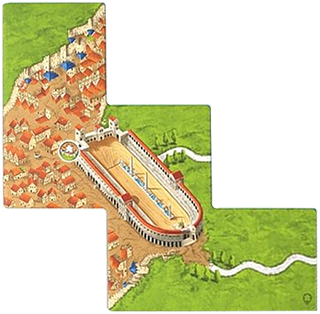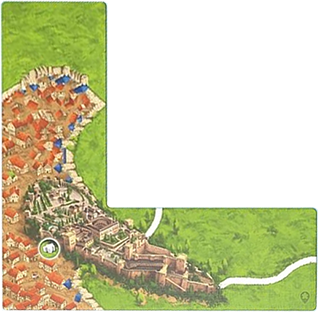The Wonders of Humanity
 |
You are reading the rules for this tile design. |
| This expansion was not published in other editions. |
| If your tiles have a different design, then choose a game from Spin-offs. |  |

The Wonders of Humanity expansion contains mega tiles spanning across 5 spaces in various configurations. Each mega tile feature a wonder built by man in different ages. Each of them brings you individual advantages. But everyone can only use one per game. Get a matching wonder quickly to benefit from it as often as possible!
The wonders of humanity have reached Carcassonne. Each of them brings you individual advantages. But everyone can only use one per game. Get the wonder you want quickly to benefit from it as often as possible!
General info and comments
The Wonders of Humanity was released by Hans im Glück in 2023. The expansion contains wonder tiles spanning across 5 spaces in various configurations. Each tile features a wonder built by man in different ages. The first set contains the following wonders. More sets will come:
- Stonehenge, a prehistoric monument located near Amesbury in southern England (UK).
- Circus Maximus, an ancient Roman chariot-racing stadium and mass entertainment venue in Rome, Italy.
- Notre-Dame, a medieval Gothic cathedral built in Paris, France.
- Alhambra, a palace and fortress complex from the 13th century located in Granada, Spain.
This expansion has cities with clipped buildings.
Contents
- 4 wonder tiles with Wonders of Humanity (each one counts as 5 contiguous square tiles)
Note: The map printed on the back of the first set of wonder tiles (Stonehenge, Notre-Dame, Circus Maximus and Alhambra) is only relevant for the Carcassonne Game Festival 2023 in Carcassonne.
Rules
Preparation
We recommend you to play with at least 90 tiles and one additional meeple (e.g. Base game + 1st expansion). [1] Ignore any additional expansion rules.
- Each player takes all 9 meeples in one color. Place 2 meeples in each color next to the 10 space outside the scoreboard.
- Note: One of these two meeples is used only to mark your wonder. You can use the large meeple of the 1st expansion or any other figure in that color.
- Place a scoring meeple as usual on the 0 space of the scoreboard. All playes start the game with 6 meeples in their supply.
- Choose 1 wonder tile per player. Place them faceup next to the scoreboard. Discard the remaining wonder tiles, you do not need them for this game.
Note: There are only 4 wonders in the first set. So you can only play with up to four players. However, there will be more sets available, that will allow you to choose the wonders and/or play with more than 4 players.
Placing a wonder tile
There is one wonder for each player. To receive a wonder tile, you must fulfill a condition. This falls under section 3. Scoring a feature described next:
3. Scoring a feature and getting a wonder tile
There is 1 wonder for each player. So you can get a wonder tile only once during the game.
When your scoring meeple reaches or exceeds the space with the meeple pairs (the first time it is the 10 space), you perform the following steps in sequence:
- Choose one of the wonder tiles available and place it in front of you. You don't place it on the game board yet (see 1. Placing a wonder tile).
- Take your two meeples next to the scoreboard and add them to your supply.
- Move all remaining meeples placed next to the scoreboard 5 spaces forward (i.e. the first time next to the 15 space, then next to the 20 space, and finally next to the 25 space).
- ATTENTION: You must never move the meeple pairs beyond the 25 space, even if there are more than 4 players. The meeples remain next to the 25 space until they are reached by all other scoring meeples.
Special case:
If several players reach the space with the meeple pairs on the same turn, the person whose turn it is chooses which of them will take a wonder tile. After that, the meeple pairs are moved 5 spaces forward as usual. If there are still scoring meeples from other players (who have not taken a wonder yet) on or past the space with the meeple pairs, the person whose turn it is decides again who will take the next wonder, and so on.
1. Placing a wonder tile
If there is a wonder tile in front of you, you do not draw a tile, but instead place your wonder tile according to the usual placement rules. [2] Once you have placed it, you have to mark your wonder with one of the 2 meeples that you obtained along with the wonder tile. To do so, place the marker meeple in the center of the wonder (not on a city, road or field). This marker meeple remains there until the end of the game. For a better distinction from other meeples, you can put the marker meeple upside down.
Note: In the very rare case that there is no way to place the wonder tile correctly, you draw a tile that you must immediately place so that you can immediately place your wonder tile (on it) afterwards. If this is not possible either, the tile is removed from the game (even if it would have fit) and you draw another tile, and so on. You do not place a meeple on the additionally drawn tile.
2. Placing a meeple on a wonder tile
After you have placed and marked your wonder, you may immediately place up to 2 meeples on different unoccupied features (city, road, monastery or field) of this wonder tile. You may also place only one or no meeples. If you place 2 meeples, they may also be placed on the same square. [3]
3. Scoring a wonder
Each wonder has its own function that can earn you points. Some wonders give you points during the game, while others give you points at the end of the game. [4]
During the game (not during the turn in which you place the Notre-Dame wonder tile), if you place a meeple on one of the 8 tiles surrounding a monastery, you immediately score 3 points. It is irrelevant if the monastery has a monk or not. [5] Even if several monasteries are adjacent to the tile where the meeple is placed, you will "only" receive 3 points. [6]
If you complete one or more occupied roads during your turn (not when playing the Stonehenge wonder tile itself), you immediately score 3 points for each road you complete (even if you don't have a meeple on the road yourself). After that, you score the road as usual. [7]
![]() Question: Do you get the Stonehenge bonus if you complete an unoccupied road and then you add a meeple to it on the tile just placed?
Question: Do you get the Stonehenge bonus if you complete an unoccupied road and then you add a meeple to it on the tile just placed?
Answer: Yes it is possible. You place the meeple in 2. Placing a meeple right before you perform 3. Scoring with a wonder. (3/2024)
At the end of the game, depending on the number of players, you will receive points for each meeple of another color in still uncompleted cities:
| 2 players: | 4 points | |
| 3-4 players: | 3 points | |
| 5+ players: | 2 points |
Important!
- Each wonder tile counts as 5 individual normal tiles. Accordingly, the roads and cities can consist of more than one tile. You must take this into account during the scoring.
- Stonehenge and Notre-Dame each have a road that spans across 2 tiles.
- The Alhambra has a city that spans across 3 tiles, the Circus Maximus has a city that spans across 4 tiles, and Notre-Dame has a city that spans across 2 tiles. [8]
Final Scoring
At the end of the game, you first score the wonders that score at the end of the game. After that, you continue with the normal final scoring. [9]
Additional clarifications
Roads, cities and fields on wonder tiles
![]() Some wonder tiles include multiple cities spreading across multiple square spaces. Each space should be counted like a separate tile. The following images illustrate the number of road and city tiles to consider for each wonder tile as well as the intended field connectivity. Blue circles represent connected fields and red circles represent separated fields.
Some wonder tiles include multiple cities spreading across multiple square spaces. Each space should be counted like a separate tile. The following images illustrate the number of road and city tiles to consider for each wonder tile as well as the intended field connectivity. Blue circles represent connected fields and red circles represent separated fields.
Notes:
- The dirt patches next to some wonders are part of the wonder, not part of the adjacent city.
- The die-cutting of the wonder tiles may affect field connectivity due to production variations. If playing with wonder tiles diverging from the intended field connectivity, players will have to agree on the field connectivity to apply.
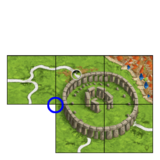 |
Stonehenge
|
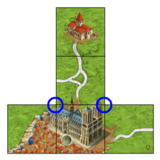 |
Notre-Dame
|
![]() Question: Does the city on the Notre-Dame wonder tile span 2 or 4 tiles? The dirt patches surrounding Notre-Dame extend to 2 adjacent square spaces (top and right). It is a bit ambiguous in visual terms, since there is no actual wall closing the city but the houseless dirt patches with Notre-Dame bordering the field.
Question: Does the city on the Notre-Dame wonder tile span 2 or 4 tiles? The dirt patches surrounding Notre-Dame extend to 2 adjacent square spaces (top and right). It is a bit ambiguous in visual terms, since there is no actual wall closing the city but the houseless dirt patches with Notre-Dame bordering the field.
Answer: The city only spans across 2 tiles. The dirt patches surrounding Notre-Dame are graphically necessary to close off the roads there. (3/2024)
![]() Question: The outer stone circle limits the surrounding fields, so there are 4 fields on the Stonehenge wonder tile. Is this correct?
Question: The outer stone circle limits the surrounding fields, so there are 4 fields on the Stonehenge wonder tile. Is this correct?
Answer: It is exactly right. (3/2024)
![]() A farmer placed in a field only bordering a wonder but not the city adjacent to the wonder will not score points for this city. This may happen to some fields on wonder tiles:
A farmer placed in a field only bordering a wonder but not the city adjacent to the wonder will not score points for this city. This may happen to some fields on wonder tiles:
- The field surrounding the monastery on the Notre-Dame wonder tile (top right)
- The field between the roads on the Circus Maximus wonder tile (center right)
- The field between the roads on the Alhambra wonder tile (center right)
Note that wonders (including the dirt patches next to them) are separate features from cities. Wonders limit cities but are not part of them.
![]() Question: Some wonders such as Notre-Dame, Circus Maximus and Alhambra include a field between two roads that touches the wonder. Is this field considered to touch the city or only the wonder (and therefore no city)?
Question: Some wonders such as Notre-Dame, Circus Maximus and Alhambra include a field between two roads that touches the wonder. Is this field considered to touch the city or only the wonder (and therefore no city)?
Answer: The field only touches the wonder. A wonder is always neutral and not part of a city. (3/2024)
The wonders in detail
Tile distribution
Footnotes
For Icons explanation and licensing please visit Icons page.
- ↑
 The initial version of the rules suggested playing with more than just the basic game tiles (about 90+) by adding any tiles you wanted (more basic game tiles or from the (mini) expansions, without applying their rules).
The initial version of the rules suggested playing with more than just the basic game tiles (about 90+) by adding any tiles you wanted (more basic game tiles or from the (mini) expansions, without applying their rules).
- ↑
 A wonder tile can be placed adjacent to another wonder tile. There is no limitation affecting their placement beyond the usual rules.
A wonder tile can be placed adjacent to another wonder tile. There is no limitation affecting their placement beyond the usual rules.
 Question: Can a wonder tile be placed adjacent to another wonder tile (edge-to-edge or corner-to-corner)?
Question: Can a wonder tile be placed adjacent to another wonder tile (edge-to-edge or corner-to-corner)?
Answer: Yes, it's possible. (10/2023)
- ↑
 This means you may occupy any two different features on the wonder tile even if they are in the same square.
This means you may occupy any two different features on the wonder tile even if they are in the same square.
- ↑
 This sentence was removed from the first revised rules, so the effect of the wonders start on your next turn after placing it:
This sentence was removed from the first revised rules, so the effect of the wonders start on your next turn after placing it:
- Starting with the turn in which you place and mark your wonder, you can use it to score points.
- ↑
 This sentence missing in the original English rules was finally added in the third revised rules released in 10/2023.
This sentence missing in the original English rules was finally added in the third revised rules released in 10/2023.
- ↑
 This sentence was updated in the second revised rules released in 10/2023.
This sentence was updated in the second revised rules released in 10/2023.
- ↑
 This paragraph was updated in the first revised rules released in 10/2023.
This paragraph was updated in the first revised rules released in 10/2023.
- ↑
 This sentence was updated according to the clarifications provided in 03/2024 for the sake of completeness and clarity.
This sentence was updated according to the clarifications provided in 03/2024 for the sake of completeness and clarity.
- ↑
 This sentence was moved to a separate section for the sake of completeness and clarity.
This sentence was moved to a separate section for the sake of completeness and clarity.
